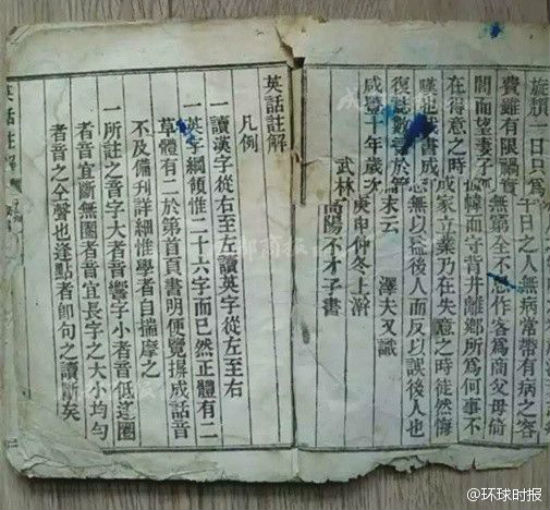How did Chinese people learn English 150 years ago?
BY Lorraine Zhou
A series of pictures of a century-old English textbook have been circulating on Chinese social media. The textbook is a collection from Mr. Yao from Sichuan Province. The cover of the textbook shows that the book was published during the tenth year of Qing Emperor Xianfeng's reign (or the year of 1860). On top of English sentences such as "tomorrow I give you answer", "to do with my friend" are their Chinese translation, and on the bottom are a phonetic translation made up of garbled Chinese words whose pronunciations correspond with the English sentence.

Adopting phonetic "translation" to learn to pronounce a foreign language, according to the analysis of historians, has been a prevalent method since the early modern times. For example, as it is shown on that textbook, "Less one half of your price" is annotated with Chinese pronunciation "Lesi wen hafu yafu you pulaisi". "If we read it in the Chinese way, no English speaker can ever understand," says Mr. Yao.



There is a paragraph of "instructions" at the beginning of the textbook: "The Chinese is read from right to left, the English is read from left to right…" And for "learning tips", the author wrote, "the learner has to figure it out by himself."

Learning instructions
Linguistic professor from Sichuan University, Lei Hanqing believes that this kind of Chinese phonetic notation was mainly found in less formal textbooks for beginners. During the late Qing Dynasty, the standard Chinese was the vernacular Mandarin spoken in Beijing, which has nuanced differences with contemporary standard Mandarin. Therefore, the phonetic notation actually made more sense in the old times when spoken in vernacular Mandarin, and was not that difficult to understand for English native speakers.
Professor Sun Guangping who specialises in the history of cultural exchange between China and the West found that in the Qing Dynasty, English textbooks started to be circulated during 1807 and 1840, mainly in the foreign trading ports in the eastern coast for the needs of commerce. Language materials written by Chinese people with Pidgin English were the most popular. In Guangzhou, a pamphlet titled "The Ghost Language" was one of those English textbooks. Samuel Wells Williams, a missionary from the United states in the early 19th century, commented that the pronunciation annotated in the pamphlet was "very awful".
Archives show that in the Qing Dynasty, people who were talented in Latin and Russian were weighted by the Qing government after the signing of the Nerchinsk Treaty.
It was not until the mid-19th century that the English education was promoted by the "Self-Strengthening Movement", a institutional reform initiated by late-Qing Chinese intellects who advocated modernising China by applying the Western systems. Some Western schools were established, and English textbooks were generally written by English native speakers with English phonetic symbols. After the Sino-Japanese War in 1895, some original English textbooks from the West were introduced into China for the first time.
Experts from the Western Sichuan Archived Document Restoration Centre verified that the printing style, font and content of Mr. Yao's collection were produced in the late Qing Dynasty.
- Publish Your Own Book with Chinese Social Media App, WeChat
- “China Was the Best Experience of My Life” – A Year of German-Chinese School and Youth Exchange
- Developing Eco-industry to Curb Desertification
- Haixi: Industrial Upgrading through Development of a Circular Economy
- How China's Silicon Valley is Developing Virtual Reality
